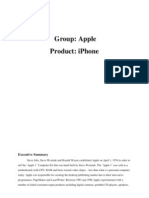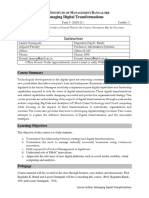Case Study - 1: Consumer Behaviour
Case Study - 1: Consumer Behaviour
Uploaded by
kirtissh bhavsaarCopyright:
Available Formats
Case Study - 1: Consumer Behaviour
Case Study - 1: Consumer Behaviour
Uploaded by
kirtissh bhavsaarOriginal Title
Copyright
Available Formats
Share this document
Did you find this document useful?
Is this content inappropriate?
Copyright:
Available Formats
Case Study - 1: Consumer Behaviour
Case Study - 1: Consumer Behaviour
Uploaded by
kirtissh bhavsaarCopyright:
Available Formats
Case Study -1
Consumer Behaviour
Kirtish Bhavsar
(20MBAGEN025)
(One Plus: Crossing the Chasm in the smartphone market)
Introduction:
Pete Lau and Carl Pei founded OnePlus in Shenzhen, China, in December 2013. Lau
previously worked as a Vice President at Oppo Mobile, a company that shared investors
with OnePlus. Regardless of the fact that the smartphone market was saturated, the
founders saw an opportunity for a new entrant. They presumed that most smartphones had
flaws such as bloatware, cheap plastic hardware, and unappealing designs. Company's
intentions were clear from the start: to create high-end, user-friendly devices that delivered
a better experience at a lower price than any other device on the market.
OnePlus launched its first smartphone, called OnePlus One, in April 2014 and quickly found
success in India, Europe, and the United States. (The OnePlus One was released in India in
December 2014 exclusively though Amazon.)
By October 2014, the OnePlus One was available in 34 countries worldwide, and the
company had recorded revenues of $300 million.
Facts:
OnePlus unveiled its first product, the OnePlus One, in April 2014 and released it
internationally in June 2014. The OnePlus One came pre-installed with a modified
version of the Android operating system called Cyanogen. The phone featured a high-
quality build, a fast processor, an excellent display, and a very attractive price. Promoted
as a “flagship killer,” it was priced at $299 for the 16GB version and $349 for the 64GB
version.
The OnePlus One was sold exclusively on the OnePlus website, marking a departure
from the typical industry practice of selling through wireless carriers. OnePlus used the
invite system for two reasons. First, the company had a limited supply of phones, so the
invite system allowed it to control supply and demand for the phones and so that the
customers perceive it is a hard-to-get hands on phone.
The company introduced its second- generation smartphone, the OnePlus 2, in July
2015.The phone was priced at $389 (for the 64GB version), almost half the price of rival
phones like Apple’s iPhone 6 and Samsung’s Galaxy S6.
In October 2015, OnePlus launched its third phone, the OnePlus X. The OnePlus X
featured an elegant design and high-quality hardware, but it sacrificed performance to
achieve the very affordable price of $249 and it lacked a lot of features compared to the
previous phones launched.
You might also like
- INTECONT ® Tersus Belt Weigher - Instruction ManualDocument167 pagesINTECONT ® Tersus Belt Weigher - Instruction ManualOscar Giovani Sosa100% (2)
- The Xiaomi Way Customer Engagement Strategies That Built One of the Largest Smartphone Companies in the WorldFrom EverandThe Xiaomi Way Customer Engagement Strategies That Built One of the Largest Smartphone Companies in the WorldNo ratings yet
- Volvo YCC CaseDocument7 pagesVolvo YCC CaseRidho Bramulya Ikhsan0% (1)
- Modu Case StudyDocument11 pagesModu Case Studyaj46910% (1)
- Apple Brand AuditDocument6 pagesApple Brand AuditSrinivas SrinuNo ratings yet
- Pepperfry Group 9 ADocument2 pagesPepperfry Group 9 Asaket ranaNo ratings yet
- AI Module 2Document47 pagesAI Module 2Nithin KsNo ratings yet
- Strategic Management of Technology Plan For AppleDocument14 pagesStrategic Management of Technology Plan For AppleDesiree Carter/Morris100% (1)
- Gez S2041 PDFDocument2 pagesGez S2041 PDFMuzzammil Nazeer100% (1)
- Marketing - Oneplus1Document23 pagesMarketing - Oneplus1hemant bishtNo ratings yet
- One PlusDocument13 pagesOne PlusAlen Mathew GeorgeNo ratings yet
- Oneplus Technology Is A Chinese Company Who Makes Smartphones, Headphones, andDocument22 pagesOneplus Technology Is A Chinese Company Who Makes Smartphones, Headphones, andMeghna JaiswalNo ratings yet
- Apple's Strategy and Place in Global MarketDocument8 pagesApple's Strategy and Place in Global MarketSimran ShriyaNo ratings yet
- Designing for the iPad: Building Applications that SellFrom EverandDesigning for the iPad: Building Applications that SellRating: 5 out of 5 stars5/5 (1)
- Innovation Equity: Assessing and Managing the Monetary Value of New Products and ServicesFrom EverandInnovation Equity: Assessing and Managing the Monetary Value of New Products and ServicesNo ratings yet
- Oneplus Word Sarah ShirvaDocument18 pagesOneplus Word Sarah Shirva57SHIRVA MOHAMMEDNo ratings yet
- A Synopsis ReportDocument16 pagesA Synopsis Reportsanu singhNo ratings yet
- B2B PGP Course Outline 2018Document8 pagesB2B PGP Course Outline 2018Er Akash SolankiNo ratings yet
- Apple and Its Marketing StrategyDocument6 pagesApple and Its Marketing StrategyArjun KhanalNo ratings yet
- SWOT Analysis of Apple IphoneDocument4 pagesSWOT Analysis of Apple IphoneihtashamNo ratings yet
- Inside The Smartphone IndustryDocument33 pagesInside The Smartphone IndustrySuraj ChhedaNo ratings yet
- Pepperfry IntroductionDocument2 pagesPepperfry Introductionssagr123No ratings yet
- Samsung VS Apple: Advertising and Marketing ResearchDocument24 pagesSamsung VS Apple: Advertising and Marketing ResearchKiran Dalvi100% (1)
- E Commerce JabongDocument24 pagesE Commerce JabongRabiba Zia100% (1)
- A Comparative Study Between Flipkart and Amazon IndiaDocument11 pagesA Comparative Study Between Flipkart and Amazon IndiaKrima J. ShahNo ratings yet
- AppleDocument17 pagesAppleyadavraj23No ratings yet
- Group: Apple Product: Iphone: Executive SummaryDocument7 pagesGroup: Apple Product: Iphone: Executive SummaryAshitosh MohiteNo ratings yet
- Apple Watch - Setting The Next Concumer Lifestyle TrendDocument26 pagesApple Watch - Setting The Next Concumer Lifestyle TrendKdmfuffad liNo ratings yet
- Quiz Pemasaran GlobalDocument8 pagesQuiz Pemasaran GlobalNurul FadhilahNo ratings yet
- Skoda Case StudyDocument4 pagesSkoda Case StudySubhankar Bhattacharjee100% (1)
- Detailed Writeup - Jaguar Land RoverDocument5 pagesDetailed Writeup - Jaguar Land RoverAkash GhoshNo ratings yet
- 5 - MDT Managing Digital TransformationsDocument4 pages5 - MDT Managing Digital TransformationsAkshayNo ratings yet
- Company Profile: LG ElectronicsDocument9 pagesCompany Profile: LG Electronicsvasu005No ratings yet
- Intel Site SelectionDocument5 pagesIntel Site SelectionSahilAviKapoorNo ratings yet
- Social and Viral MarketingDocument13 pagesSocial and Viral Marketingsaleem razaNo ratings yet
- Adult Diaper Industry in India Market ResearchDocument3 pagesAdult Diaper Industry in India Market ResearchVaibhav Baheti100% (1)
- MARK 502 - Omnichannel RetailingDocument5 pagesMARK 502 - Omnichannel RetailingShivaniNo ratings yet
- Consumer Study Buying BehaviourDocument22 pagesConsumer Study Buying BehaviourArhan KhanNo ratings yet
- Oreo in India - Launching and Establishing A Global Brand in India Using Integrated Marketing Communications EffectivelyDocument2 pagesOreo in India - Launching and Establishing A Global Brand in India Using Integrated Marketing Communications EffectivelyNIKITA SONINo ratings yet
- Report On AppleDocument27 pagesReport On AppleJoy BiswasNo ratings yet
- Retail Marketing: SEM - III (2019-2021) Group 5Document13 pagesRetail Marketing: SEM - III (2019-2021) Group 5Mahesh PawarNo ratings yet
- Assignment No.1 1Document5 pagesAssignment No.1 1pktunNo ratings yet
- Brand ManagementDocument6 pagesBrand ManagementAnubhov JobairNo ratings yet
- Innovative Products: Intermedio 8Document14 pagesInnovative Products: Intermedio 8Axel Sebastian Cayllahua SotoNo ratings yet
- 7 Case AnswerDocument8 pages7 Case AnswerDevid LuizNo ratings yet
- Positioning: As Popularized by Al Ries and Jack TroutDocument49 pagesPositioning: As Popularized by Al Ries and Jack Troutpannazz100% (1)
- Individual Assign-Strategic MDocument12 pagesIndividual Assign-Strategic MAddis GetachewNo ratings yet
- GoogleDocument28 pagesGoogleAnkit JoshiNo ratings yet
- Samsung Mobile PhoneDocument16 pagesSamsung Mobile PhoneM Imran NaeemNo ratings yet
- Marketing Strategy of AppleDocument5 pagesMarketing Strategy of AppleShariar Masud TowhidNo ratings yet
- Full Report Case Study 1 Honda Yamaha WarDocument7 pagesFull Report Case Study 1 Honda Yamaha Warnorfainahosminya33% (3)
- Activity Sheet: Eiou FrameworkDocument5 pagesActivity Sheet: Eiou FrameworkAjinkya JadhavNo ratings yet
- Apple Pestel AnalysisDocument3 pagesApple Pestel AnalysisMiracles EspinalNo ratings yet
- Marketing Research ProjectDocument39 pagesMarketing Research ProjectR Rama Koteswara RajuNo ratings yet
- Apollo HospitalsDocument5 pagesApollo HospitalsArnab ChatterjeeNo ratings yet
- Reebok and Adidas MergerDocument11 pagesReebok and Adidas MergerGautam ChinnappaNo ratings yet
- Consumer Behaviour in Post-Covid EraDocument1 pageConsumer Behaviour in Post-Covid EraAkash DhimanNo ratings yet
- Critical Reflective Assignment: Bbmk504 Brand ManagementindividualDocument9 pagesCritical Reflective Assignment: Bbmk504 Brand ManagementindividualPhạmAnhThư100% (1)
- Revitalize The Brand Using The Existing Brand EquityDocument12 pagesRevitalize The Brand Using The Existing Brand Equitypriyani100% (1)
- Business Model of Cork'dDocument2 pagesBusiness Model of Cork'dPritish EkkaNo ratings yet
- KirtishBhavsar 20MBAGEN025 CB Case-2Document3 pagesKirtishBhavsar 20MBAGEN025 CB Case-2kirtissh bhavsaarNo ratings yet
- Consumer Behaviour: by Kirtish Bhavsar JanviDocument7 pagesConsumer Behaviour: by Kirtish Bhavsar Janvikirtissh bhavsaarNo ratings yet
- 20gen023 - 20gen025 (Janvi, Kirtish Bhavsar) CB AssignmentDocument7 pages20gen023 - 20gen025 (Janvi, Kirtish Bhavsar) CB Assignmentkirtissh bhavsaarNo ratings yet
- Patanjali Case StudyDocument3 pagesPatanjali Case Studykirtissh bhavsaarNo ratings yet
- 10 Inspiring Examples of Successful IntrapreneurshipDocument6 pages10 Inspiring Examples of Successful Intrapreneurshipkirtissh bhavsaarNo ratings yet
- Case of Human Resource, ManagementDocument2 pagesCase of Human Resource, Managementkirtissh bhavsaar100% (1)
- DVP-NS648P - DVD Player - DVD - HDD Players - Sony Asia PacificDocument4 pagesDVP-NS648P - DVD Player - DVD - HDD Players - Sony Asia PacificAhsan RafiqNo ratings yet
- CN 900Document13 pagesCN 900moyali25176750No ratings yet
- Buy Ionix Digital Jewellery Scale Electronic WeiDocument1 pageBuy Ionix Digital Jewellery Scale Electronic WeiCraj RajNo ratings yet
- Computer Graphics MCQDocument23 pagesComputer Graphics MCQBobby Deol100% (1)
- UG - Rexton Targa S P HP 5 EN - Rev02 - Screen 1Document36 pagesUG - Rexton Targa S P HP 5 EN - Rev02 - Screen 1ruben mendezNo ratings yet
- FTE Qualified Switch Firmware VersionsDocument15 pagesFTE Qualified Switch Firmware VersionsAnton SaitovNo ratings yet
- Technology-Based ArtDocument48 pagesTechnology-Based ArtKevin Jay Mendoza MagbooNo ratings yet
- Valtra A Katalog A72!92!09 PLDocument37 pagesValtra A Katalog A72!92!09 PLStanisław DuszczakNo ratings yet
- PDF Beginning Android 1st Edition Mark Murphy downloadDocument67 pagesPDF Beginning Android 1st Edition Mark Murphy downloadvarraadeles0100% (2)
- IBM Sterling Warehouse Management System: Increase Warehouse Productivity and Reduce CostsDocument5 pagesIBM Sterling Warehouse Management System: Increase Warehouse Productivity and Reduce CostsRishard MohamedNo ratings yet
- Collaborate With Ease: Wireless Presentation Made SimpleDocument2 pagesCollaborate With Ease: Wireless Presentation Made Simplekorvuz80No ratings yet
- Ultrasonic oDocument18 pagesUltrasonic oAndres ParedesNo ratings yet
- Curs HTMLDocument70 pagesCurs HTMLplastecNo ratings yet
- AI Lec01Document57 pagesAI Lec01zain ghuman zainNo ratings yet
- Bid Proposals and Cover Letter For Apply On Projects Aamir DaniyalDocument13 pagesBid Proposals and Cover Letter For Apply On Projects Aamir DaniyalImranNo ratings yet
- Change Control WHODocument62 pagesChange Control WHOsubirybajar100% (2)
- K.Ramakrishnan College of Engineering: Samayapurm, Trichy-621 112Document2 pagesK.Ramakrishnan College of Engineering: Samayapurm, Trichy-621 112ManimegalaiNo ratings yet
- SVT - File ManualDocument73 pagesSVT - File ManualArnav BansalNo ratings yet
- ESD Handout 12Document4 pagesESD Handout 12GH HussainNo ratings yet
- Robotics Lectures-1 For Final Year Indir PDFDocument93 pagesRobotics Lectures-1 For Final Year Indir PDFume habibaNo ratings yet
- FB Cooler CBK and PCF DataDocument4 pagesFB Cooler CBK and PCF DataWilki SantanderNo ratings yet
- 10874-2009 IsoDocument8 pages10874-2009 IsoVan Thu DangNo ratings yet
- Mechatronic Systems Catalog: German - EnglishDocument104 pagesMechatronic Systems Catalog: German - EnglishVent system СервисNo ratings yet
- Network Security and CryptographyDocument16 pagesNetwork Security and CryptographyvaralakshmiNo ratings yet
- Module 4Document14 pagesModule 4maha.kandadaiNo ratings yet
- Amplificador Da Rede Can HHMDocument14 pagesAmplificador Da Rede Can HHMPaulo SilvaNo ratings yet
- Unsolved MCQsDocument2 pagesUnsolved MCQsRomi AwanNo ratings yet
- Audit Break: Audited SEU: Conveyor Cementing, Chamber Oven and Autoclave Tank + OTHDocument1 pageAudit Break: Audited SEU: Conveyor Cementing, Chamber Oven and Autoclave Tank + OTHVeny Eka SaputriNo ratings yet































































































